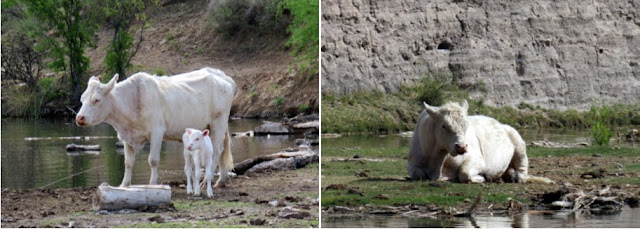At the Stage Stop Inn, we tried to sleep in but were up by 6:00 and on the road by 7:00. Our boat trip around Patagonia Lake was scheduled for 11:00, so we decided that we had plenty of time to explore Sonoita Creek State Natural Area at the south end of the lake. We parked in a trailhead parking lot, which was at the top of a long, very steep concrete ramp leading to the spillway. We carefully descended to the spillway on this ramp. Cattle were on and beside it and also at the spillway. The spillway had a trickle of water running over it, and negotiating our way past the cattle, we were able to spot some shorebirds, which we failed to identify, two Snowy Egrets, a pair of Cinnamon Teal, and a pair of Blue-winged Teal.
 After exploring only the spillway area, we donned crampons and used our pickaxes to climb back up the steep road (just kidding) and then drove a mere few yards to Patagonia Lake Visitor's Center, preparatory to our boat tour. Paul Bylsma was the boat captain and Carol Bylsma the bird guide for Deb and me and and five others. We motored slowly around the shores of the lake, seeing American Coots, Lesser and Neotropical Cormorants, a Black Phoebe, Western Grebe, Clark’s Grebe and an Intergrade or Hybrid grebe with one side of it's face Western and the other Clark's. Paul told us the history of the lake and Carol pointed out a yellow mud turtle.
After exploring only the spillway area, we donned crampons and used our pickaxes to climb back up the steep road (just kidding) and then drove a mere few yards to Patagonia Lake Visitor's Center, preparatory to our boat tour. Paul Bylsma was the boat captain and Carol Bylsma the bird guide for Deb and me and and five others. We motored slowly around the shores of the lake, seeing American Coots, Lesser and Neotropical Cormorants, a Black Phoebe, Western Grebe, Clark’s Grebe and an Intergrade or Hybrid grebe with one side of it's face Western and the other Clark's. Paul told us the history of the lake and Carol pointed out a yellow mud turtle.  |
| Western Grebe (left) and Clark's Grebe (right); the hybrid or intergrade of these two had western facial markings and eye on one side of its head and Clark's on the other. |
 |
| Black Phoebe |
 |
| Pyracanthia (Internet) |
It was exceedingly hot—in the high 90s—so we chose to first walk the shorter Santa Gertrudis Lane, which intersects the de Anza trail. The women in the birding store told us that phainopeplas were feeding on a large section of tall pyracantha along the lane, but the shrubs were not in berry or the birds must have come and gone because there was not a berry or a bird on the plants.
We walked Santa Gertrudis Lane until we came to the Santa Cruz River, now a nearly dry streambed. On the way to the river we did see a Black Phoebe but not much else, and certainly not the Sinaloa Wren that had been reported in detail. In so much detail in fact, that hoards of birders had created trails and trampled the area where the bird was reportedly seen. Earlier, Carol had cautioned about giving GPS coordinates and too much detail in e-bird reports because the avid birders such specific directions attracted often caused birds to abandon their nests or leave the area. The Sinaloa Wren, in case you are wondering, is a medium sized wren endemic to western Mexico. Its range has been expanding northwards in recent decades, and the Sinaloa Wren is now a rare but regular visitor to southern Arizona.
When Santa Gertrudis Lane turned up little, we walked the de Anza trail for a couple of miles, also seeing nothing we had not already seen and not finding the elusive Rose-throated Becard. We saw some Summer Tanagers and met one person on the trail. He tried, but failed, to give us directions to the bridge where the becards had been seen (more about that later).
It was a long, hot day, so when we got back to Patagonia, we again ate dinner--hamburger sandwiches again--at the Wagon Wheel, this time about 7:00.
We walked Santa Gertrudis Lane until we came to the Santa Cruz River, now a nearly dry streambed. On the way to the river we did see a Black Phoebe but not much else, and certainly not the Sinaloa Wren that had been reported in detail. In so much detail in fact, that hoards of birders had created trails and trampled the area where the bird was reportedly seen. Earlier, Carol had cautioned about giving GPS coordinates and too much detail in e-bird reports because the avid birders such specific directions attracted often caused birds to abandon their nests or leave the area. The Sinaloa Wren, in case you are wondering, is a medium sized wren endemic to western Mexico. Its range has been expanding northwards in recent decades, and the Sinaloa Wren is now a rare but regular visitor to southern Arizona.
When Santa Gertrudis Lane turned up little, we walked the de Anza trail for a couple of miles, also seeing nothing we had not already seen and not finding the elusive Rose-throated Becard. We saw some Summer Tanagers and met one person on the trail. He tried, but failed, to give us directions to the bridge where the becards had been seen (more about that later).
It was a long, hot day, so when we got back to Patagonia, we again ate dinner--hamburger sandwiches again--at the Wagon Wheel, this time about 7:00.






No comments:
Post a Comment